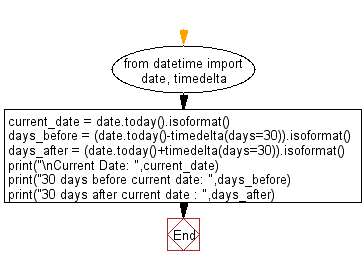Python: Get the dates 30 days before and after from the current date
Python Datetime: Exercise-28 with Solution
Write a Python program to get the dates 30 days before and after from the current date.
Sample Solution:-
Python Code:
from datetime import date, timedelta
current_date = date.today().isoformat()
days_before = (date.today()-timedelta(days=30)).isoformat()
days_after = (date.today()+timedelta(days=30)).isoformat()
print("\nCurrent Date: ",current_date)
print("30 days before current date: ",days_before)
print("30 days after current date : ",days_after)
Sample Output:
Current Date: 2017-05-06 30 days before current date: 2017-04-06 30 days after current date : 2017-06-05
Flowchart:

Visualize Python code execution:
The following tool visualize what the computer is doing step-by-step as it executes the said program:
Python Code Editor:
Contribute your code and comments through Disqus.
Previous: Write a Python program to create 12 fixed dates from a specified date over a given period. The difference between two dates will be 20.
Next: Write a Python program to get the GMT and local current time.
What is the difficulty level of this exercise?
Test your Programming skills with w3resource's quiz.
Python: Tips of the Day
Find current directory and file's directory:
To get the full path to the directory a Python file is contained in, write this in that file:
import os dir_path = os.path.dirname(os.path.realpath(__file__))
(Note that the incantation above won't work if you've already used os.chdir() to change your current working directory, since the value of the __file__ constant is relative to the current working directory and is not changed by an os.chdir() call.)
To get the current working directory use
import os cwd = os.getcwd()
Documentation references for the modules, constants and functions used above:
- The os and os.path modules.
- The __file__ constant
- os.path.realpath(path) (returns "the canonical path of the specified filename, eliminating any symbolic links encountered in the path")
- os.path.dirname(path) (returns "the directory name of pathname path")
- os.getcwd() (returns "a string representing the current working directory")
- os.chdir(path) ("change the current working directory to path")
Ref: https://bit.ly/3fy0R6m
- New Content published on w3resource:
- HTML-CSS Practical: Exercises, Practice, Solution
- Java Regular Expression: Exercises, Practice, Solution
- Scala Programming Exercises, Practice, Solution
- Python Itertools exercises
- Python Numpy exercises
- Python GeoPy Package exercises
- Python Pandas exercises
- Python nltk exercises
- Python BeautifulSoup exercises
- Form Template
- Composer - PHP Package Manager
- PHPUnit - PHP Testing
- Laravel - PHP Framework
- Angular - JavaScript Framework
- Vue - JavaScript Framework
- Jest - JavaScript Testing Framework
